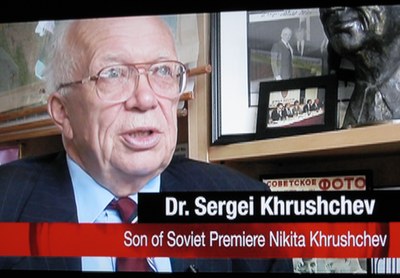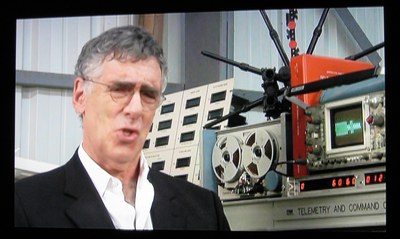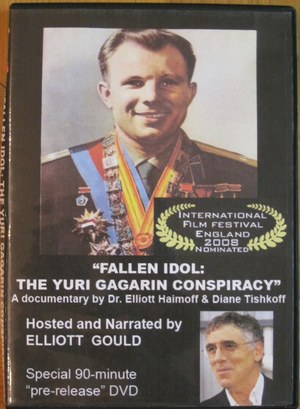Review: Fallen Idol: The Yuri Gagarin Conspiracyby James Oberg
|
| Many people claimed—and as we shall see, still claim—that the first man in space was actually Vladimir Ilyushin, a noted Soviet test pilot and son of the leading aircraft designer. |
In 2009 we saw the release of “Fallen Idol: The Yuri Gagarin Conspiracy”, a new program that was an outgrowth of a 1999 documentary, “The Cosmonaut Coverup”, both produced by a veteran team led by Elliott Haimoff of Global Science Productions. It alleged that Vladimir Ilyushin was really the first man to orbit Earth. This was supposed to have occurred on April 7, 1961, but Ilyushin was off course and badly injured on landing, and came down in China, where he was held prisoner for a full year. The Chinese agreed to cooperate with the USSR’s pretense that Gagarin (launched April 12) was really the first man in orbit.
Both programs contained some very interesting lengthy comments from Dennis Ogden, the British journalist who, in 1961, sparked the original version of the story while serving as the Moscow correspondent for the communist newspaper Daily Worker. Ogden died a few years after the release of the first DVD.
Besides Ogden, a major promoter of the theory was Gordon Feller, billed as publisher of “Russian Business News”, who in Final Frontier magazine had written that he had been given access in the Kremlin to documents detailing all of the original secret cosmonaut disasters. But curiously, the material he disclosed was precisely the same set of stories that I’d been debunking since about 1973—nothing new had been added. He described how he was allowed to examine the material, but could not take any notes, so he had to keep going outside of the building to write things down (he did not explain what he did with these contraband notes when he repeatedly returned to the building to memorize more names). Both Mike Cassutt and I wrote stern letters to Final Frontier, with my letter explaining why I found Feller’s narrative impossible to believe. Feller is highlighted in the new production as well and I’ve found no reason to revise my initial assessment of his story’s credibility.
The Ilyushin theory has now been expanded with new interviews and evidence, and reissued. It seems odd that no effort appears to have been made to promote this film at this seemingly perfect moment, but it’s still worth attention for being the best-ever formulation of the claim. But is “best” even “good enough”?
Narrator Elliott Gould opens the program with a promise of “brand-new declassified evidence” that will establish the reality of “the lies and deceit… [of] a joint US and Russian government coverup.” As a result, he promises, “Ultimately all of the history books of the world will have to be changed.”
The recorded testimony of a number of the experts interviewed was used to portray the secrecy and deception policies of the USSR in the period of the Space Race. Extensive sound bites are presented from Sergey Khrushchev, son of Nikita Khrushchev and now a professor emeritus at Brown University. But curiously, the program has no segment in which Khrushchev fils actually endorses the Ilyushin theory.
The reason is simple. He told them the theory was bunk, so they decided not to use those comments. In an email of August 11, 2009, he gave me the following statement:
“Gagarin was the first cosmonaut and Vladimir Illushin never was in the cosmonaut group. He was test pilot and had car accident. I told this on camera, Mr. Haimoff argued that he has evidence, I answered that I KNOW and advised him to ask Illushin. He answered that he asked, Illushin denied, ‘because his was instructed to do so’. This is the story, the rest is manipulation with the tape, you know that it is possible to do everything that you want. I do not know any Russian historian who believe in this absurd version.”
Khrushchev, mind you, is one of the experts the program presents to support their thesis.
But Ilyushin is the hero of the piece, and evidence can be found in the sincerity of people who do believe that narrative. Gordon Feller, presented as a “Soviet space historian” (but with no record of actually publishing anything significant on that subject), states: “In my view [Ilyushin] was an obvious choice, it was no accident [he was first]”. Another proponent of the theory is Racheal Seymour, who appears in her interviews as a young woman with a severe hairstyle and studious eyeglasses, with a caption identifying her as a former CIA space analyst. Ilyushin, she testifies, “was considered a shoo-in for the first flight into space.”
 Khrushchev’s comments were carefully selected to appear supportive, but he really thinks the Ilyushin theory is nonsense. (credit: J. Oberg) |
An old clip of the aged Dennis Ogden follows: “A photo of Ilyushin wearing space gear was published saying he was undergoing training as a cosmonaut,” he states. But even after more than fifteen years of research on both programs, the photograph has never been found. The image that the program shows is actually of Gennadiy Zavadovskiy, identified officially (and credibly, as we’ll see) as a “tester” of aviation equipment, wearing a standard high-altitude pressure suit. But Ogden repeats the claim: “I had seen a photograph of Vladimir Ilyushin wearing space gear and referred to as a member of the cosmonaut group.”
Narrator Gould refers to inept Soviet press denials: “At first they presented Col. Ilyushin as having been a cosmonaut in training but one who just didn’t get to go up into space… at that time. Then the story evolved to where Col. Ilyushin was never a cosmonaut trainee… The story changed, that he was a cosmonaut in training but recently had been in a car accident.” The implication: clumsy lies betokened a deep, dark secret.
| The program’s “Ilyushin scenario” is also internally inconsistent. |
But where are such articles and such photographs? Gould has the perfect excuse: a borzoi ate them, sort of. “Photos and film clips and references to Colonel Ilyushin as a cosmonaut seemed like they’d been erased from existence,” he complains (including those in Western archives and private hands, we must presume). “The Soviets clearly excised evidence of Ilyushin’s flight exactly like they did for the Nedelin rocket disaster and all other failures of any space agency program or cosmonaut dropout,” he added, implying that absence of evidence of a conspiracy is proof of the existence of the conspiracy. But all such other disasters worked their way out past the secrecy—all, except the Ilyushin mission, it seems.
Gennadiy Zavadovskiy played an unwitting role in the Ilyushin rumors and other stories of secret space fatalities in those years. Officially he was part of a team of men at the Institute of Aviation and Aerospace Biomedicine who were testing crew equipment for extreme flight. He and his colleagues Aleksey Belokonov, Ivan Kachur, Aleksey Grachev, and Gennadiy Mikhaylov were often profiled in the Moscow press. Some Western newsmen suspected they really were cosmonaut trainees (they actually did hope to become such), and when they weren’t launched into orbit, it was logical to presume they’d been killed on secret flights in the 1962–3 period. Their names were on many “secret lists”.
Some recently-released photographs and articles have settled that uncertainty. Early in 1967, as tribute to their pioneering contributions, Yuri Gagarin visited the tester institute and was photographed with Zavadovskiy and Belokonov, both still alive. In the clear photos, released only a year ago, he’s wearing his 1967-era medals and rank, so the date is reliable, even though it was years after they were reported “dead in space” in many articles, including Gordon Feller’s.
And in a long profile of the tester team published in a Russian newspaper in 2005 (“Gagarin Was Twelfth?”), Belokonov’s son recalled overhearing a West German news report claiming: “In the Soviet Union one more cosmonaut has perished. Cosmonaut Aleksey Belokonov became the latest victim. His last words were, ‘I have an oxygen leak.’”
His father (who died in 1991) was amused by the Western reports. “In the beginning of the ’80s,” he told historian Andrey Moissenko, “my father told the scientific reporter of Komsomolskaya, Yaroslav Golovanov, that, as he saw it, the myth about the so-called ‘flights’ could have been developed by the KGB for diverting eyes from the real team of cosmonauts.” If so, it certainly worked—and is still working to this day.
The program’s “Ilyushin scenario” is also internally inconsistent. At some points, they accept Ogden’s story that it occurred on April 7, five days before the official flight. But at other times, the theory is that it occurred on March 25, the day of the flight of an unmanned Vostok carrying a dog and a dummy named “Ivan Ivanovich”. As Gould proclaimed, “To account for Ilyushin’s flight the Soviets just claimed they had sent up a crash-test dummy that had electrodes attached to its body, saying that it was used for an unmanned mission as a safety precaution, just a precursor to Gagarin’s flight.”
 Gould narrated the film as if he really were the investigative journalist he played in Capricorn One. (credit: J. Oberg) |
Gould triumphantly unveiled the piece de resistance of the Ilyushin evidence: “Unfortunately for the propagandists, the US Air Force tracking facility at Tern Island was able to clearly pick up a heartbeat, that of a human occupant, detected and tracked in real time. And it was consistent with that of a person in extreme danger.”
| By trying to prove this theory, Haimoff has performed a useful service to history: if this is the best case that can be made for it, it didn’t happen that way. |
Just what was the characteristic of the heartbeat that revealed its owner was in “extreme danger”? Gould never explained that part, but the radio operator at Tern Island (with whom I’ve been in touch for years) told me it was the very high pulse rate—about 130 beats per minute, truly a near-catastrophic rate that a human wouldn’t long survive. But fortunately, normal canine pulse rates are in the 120–140 beats/minute range, and the dog (whose rate was actually being heard) survived the mission perfectly.
To prove the flight was secretly carrying a human, what the program had done was to first tacitly assume the flight was carrying a human, so the heartbeat was too fast. Naturally, any argument to prove “A is true” will work, if assuming “A is true” is one of the initial parameters.
The program’s scriptwriter often did not even read the documents cited as evidence. For example, regarding operations on Tern Island, Gould reported: “We requested these documents and materials… The NSA response was: ‘these documents [sic] are classified…’” This directly implies the letter admitted the requested documents actually exist but are not being released.
If one screen-grabs the image of the letter flashed briefly, however, this is the real text: “One document was located which is responsive to your request. Although the document does not directly relate to the topics of your request, it was found to be responsive because it refers in passing to a manned Soviet space flight… The document is classified because its disclosure could reasonably be expected to cause exceptionally grave danger to national security, and is exempt from automatic declassification.”
Gould is clearly being sloppy by what “these documents” really mean. The documents the program demanded were not found. A marginally related document was found but is exempt from declassification. Nothing in the response acknowledges anything to confirm any aspect of the program’s theory.
Much of the later program is devoted to the Soyuz-1 stories associated with the tales in Starman from the dubious witness Venyamin Russovskiy. This aspect can best be discussed in a separate essay.
In discussing the theory that Gagarin was subsequently murdered by Kremlin officials, the program resorts to supportive facts not supported by documentation. “It was reported the jet experienced engine failure, spiraled to the ground, and crashed,” says Gould, inaccurately—the engine was running on impact, and there was no radar evidence of any spiral. “This was Gagarin’s very first flight after seven years of being grounded.” But it wasn’t. He’d been flying all spring with a trainer, and this was the last flight before being allowed to solo.
In the end, the program must explain why Ilyushin still wouldn’t confess to making the flight. Seymour, who identifies herself as a “former CIA analyst” and may have at least been a summer intern, but is now a professional daytime soap actress, grapples with the puzzle: “In my mind one of the most perplexing questions about the whole affair is why Ilyushin, why would his fellow cosmonauts, the Russians, the Chinese, the US government, why would they want to remain quiet on this for so many years. I mean the answer on the individual level is that Ilyushin and his colleagues have been heavily subsidized by the government, and they’re high-ranking military officials, they just don’t want to make waves. Now on a government level they just don’t want their people to be asking what else has been kept secret, how else have we been lied to?”
Gould provides the ultimate irony with his closing comments: “I for one can’t in good conscience sit back and allow or tolerate falsified history books, governmental cover-ups, and international conspiracies to continue without question. The same spirit is within me now for real, the same heartfelt need to seek the truth, as the investigative reporter I played in Capricorn One.” Confusing one’s real life with roles one has played is the bane of the acting profession, from Ronald Reagan to the present day.
“At the very least I feel we have planted a flag of journalistic integrity and honesty,” Gould continues, “a seed of questions to begin to set the record straight about Yuri Gagarin, Vladimir Ilyushin, and the practices and procedures of the old communist Soviet empire. I guess I leave history to the historian. Thank you for joining me on this journey.”
| Gagarin made the flight, and he made it first. Ilyushin, who died last year without ever confirming Haimoff’s theories, has an honored place in Soviet aviation history—but not in spaceflight. |
A fitting afterword is producer Haimoff’s bitter complaint about why nobody seems to believe his theory. In an email shortly after the release of the first of these two DVDs, he wrote: “I am just disgusted with all of your doubters and ‘James Oberg’-type clones who have just been duped for the last 40 years, and are just expressing their ‘sour grapes’ over not being able to root out this story first, or hold up books and articles of 40 years of Russian propaganda and tell the world that this is the truth beyond any shadow of a doubt.” By trying to prove this theory, Haimoff has performed a useful service to history: if this is the best case that can be made for it, it didn’t happen that way.
Since Russian space history is certainly more an art than a science, and Soviet secrecy has made the process triply-difficult, those engaged in the effort have learned the humility to expect being blindsided by new revelations and testimonials. Some people’s claims are still subject to debate, and some surprises are sure to pop up. But with the vast documentation now on hand, including memoirs of top people such as Kamenin, Mishin, Chertok, and others, the broad outline seems fairly well established. Gagarin made the flight, and he made it first. Ilyushin, who died last year without ever confirming Haimoff’s theories, has an honored place in Soviet aviation history—but not in spaceflight. And even researchers on dead-ended wild-goose chases help establish the boundaries of the credible versus the incredible.
